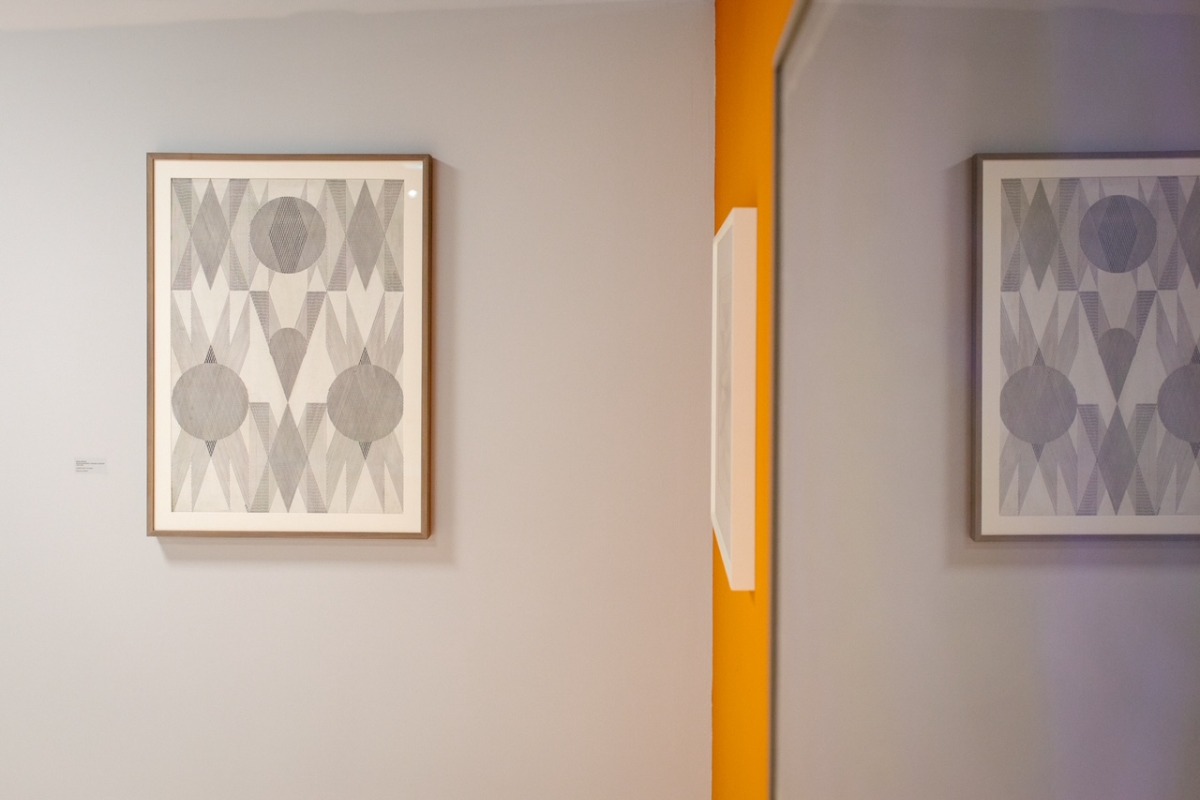
Tracing the Spiral: Stefan Bertalan in Timisoara
Notes on the Ștefan Bertalan Retrospective in Timișoara
From the hotel – which, according to the sign on the building’s façade, once housed the Colombian embassy – I walk through narrow streets that at times feel more like informal trails carved by habit and convenience. I’m headed to the ISHO Center, where an exhibition dedicated to Ștefan Bertalan (1930–2014), one of the most significant figures of the Romanian neo – avant – garde, is currently on display. As I walk, I begin to wonder whether the word terroir – typically used to describe the environmental factors that shape the character of wine – might also apply to cities: their particular patina, their potential to nurture vibrant personalities and catalyze meaningful events. And not just momentarily, but with a kind of enduring continuity – across not only years, but generations.
Stefan Bertalan. Untitled, 1986-1988 © Remus Daescu
Timișoara, the informal capital of Romania’s historic Banat region, is just such a place. It has always existed on the margins of kingdoms, empires, and states – perpetually positioned between frontiers. Occupied by the Ottomans for 160 years, it was liberated by the Habsburgs in 1716. It is a city – a bustling laboratory – where the breath of the world has long intertwined with national traditions.
Over time, diverse ethnic communities – Romanians, Germans, Hungarians, Serbs, Croats, Italians, Spaniards, Greeks, Roma, Bulgarians, among others – have coexisted, learning to accept one another and, in doing so, creating a fertile ground for innovation and experimentation. In 1771, Temeswarer Nachrichten, the first German – language newspaper in Central and Southeastern Europe, was printed in Timișoara. In 1884, it became the first city in mainland Europe to install electric street lighting.
Even under communist rule, Timișoara managed to preserve its identity. Its central square is framed by Baroque architecture, Roman Catholic and Serbian Orthodox cathedrals, the Baroque Palace, and the Prague Column – all standing in contrast to the looming silhouettes of the concrete ghosts of the communist era.
In the 1960s, Timișoara emerged as a dynamic center of artistic and intellectual innovation. What made the city truly remarkable was its unique convergence: its artistic circles attracted not only painters and poets, but also physicists, mathematicians, and researchers from the exact sciences. It became a true crossroads of ideas – a living laboratory where disciplines interacted freely.
It was within this fertile environment that two of the era’s most revolutionary art movements took shape: the experimental groups 111 and Sigma. The Sigma Group drew inspiration from the Bauhaus, Constructivism, and the emerging zeitgeist in art and architecture. Through their work, they explored new ways of understanding the world, using the language of art as a tool for inquiry and analysis.
Sigma also stood out for its strong academic connections, with members holding teaching positions at universities in Timișoara. Embracing the principles of nature and the natural world, the group cultivated a spirit of experimentation that was well ahead of its time – and ultimately became a symbol of creative freedom under a repressive regime.
Perhaps it was this spirit of openness that helped spark the first flames of revolution in December 1989. It was here, in Timișoara, that Romania’s communist regime began to unravel, culminating in the arrest of Nicolae Ceaușescu and his wife. Fittingly, the end of an era was announced not from a pulpit or parliament, but from the balcony of the National Theater and Opera House – a gesture both symbolic and profoundly rooted in the city’s cultural fabric.
Opening of the exhibition 'In Tune With the World'. Photo: © Remus Daescu
Today, Timișoara remains Romania’s third – largest city, home to approximately 315,000 residents. In 2023, it proudly held the title of European Capital of Culture under the fitting motto: “Shine your light!” – a call that echoes its enduring legacy as a beacon of creativity, resistance, and renewal.
One of the key driving forces behind Timișoara’s contemporary art scene is entrepreneur and collector Ovidiu Șandor. His journey into collecting began with antique books and maps – now numbering over 2,000 – before expanding into the world of visual art. Today, he is one of Romania’s most dedicated art patrons, actively involved with the collectors’ councils of both the Centre Pompidou in Paris and Tate in London. His primary business lies in real estate, but, as he often says, “he invests his profits in art.”
Through his foundation, Art Encounters – an open and dynamic cultural platform – Ovidiu Șandor has created a vibrant hub for contemporary art in Timișoara. Works from his collection are regularly featured in exhibitions both locally and internationally. The foundation supports cultural diversity by promoting some of the most significant Romanian contemporary artists, while also encouraging and sustaining young initiatives. It organizes exhibitions, publications, educational activities, workshops, and conferences, as well as the Art Encounters Biennial, which is already well known on the international scene. (From May 30 to July 13, 2025, Timișoara will host the sixth edition of the Biennial, titled Bounding Histories. Whispering Tales.)
Opening of the exhibition 'In Tune With the World'. Photo: © Remus Daescu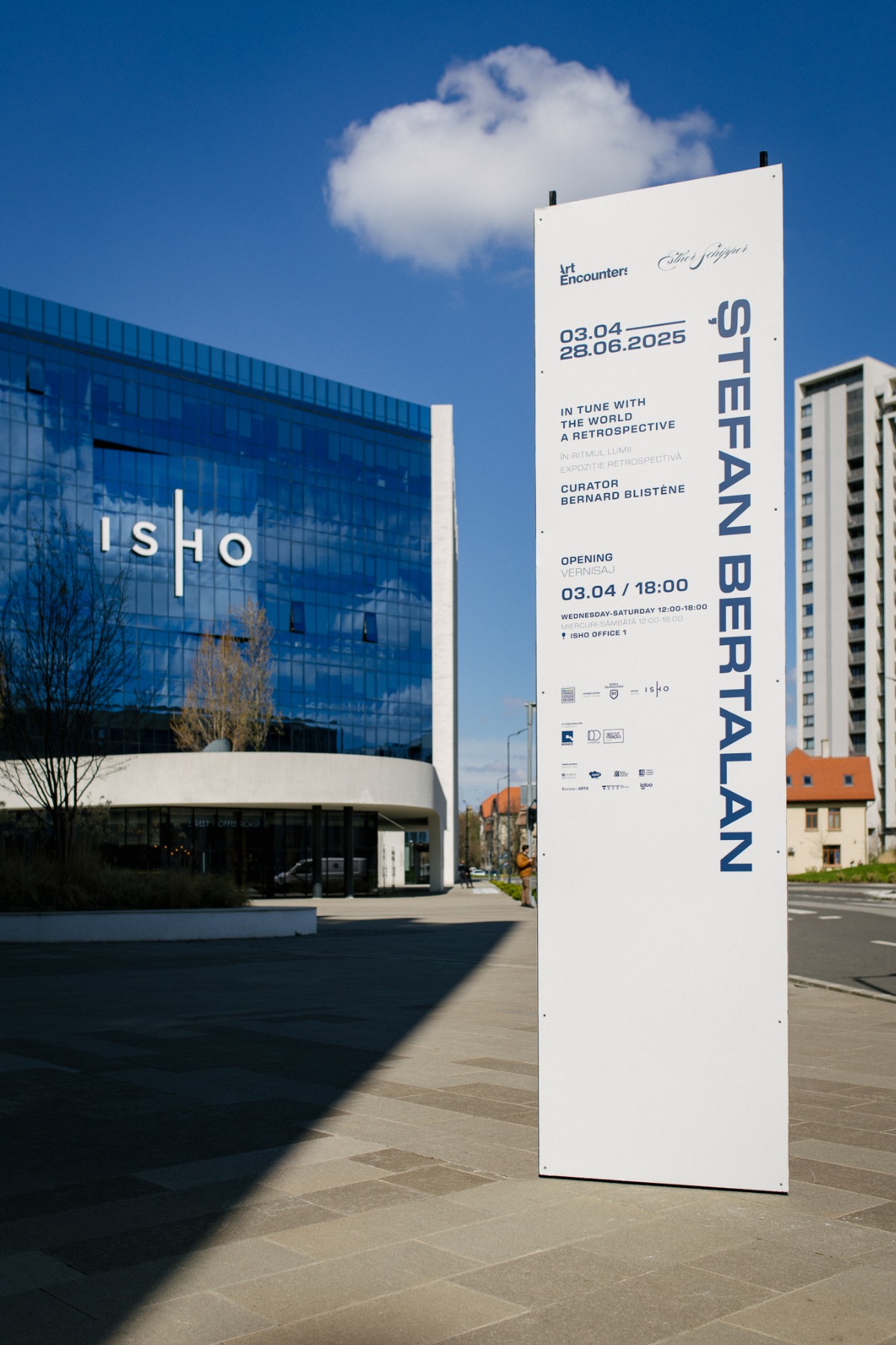
Ovidiu Șandor’s deep connection to art was perfectly illustrated by a brief remark he made at the opening of the Bertalan exhibition. He revealed that, at one point, he realized the existing Art Encounters premises were too small to accommodate such a large – scale retrospective. As a result, he decided to convert part of one of his real estate developments – the ISHO complex – into a temporary exhibition space.
Titled In Tune With the World and spanning over 1,000 m², Bertalan’s retrospective runs from April 3 to June 29, 2025. Featuring more than 250 works, the exhibition invites viewers into Bertalan’s mysterious microcosm – a space where curiosity, philosophy, mathematics, cybernetics, spirituality, and imagination intertwine. It explores the search for one’s place on Earth and in the universe, revealing a profound connection with the surrounding world – and, in a sense, a journey of identification with it and merging into it.
Opening of the exhibition 'In Tune With the World'. Photo: © Remus Daescu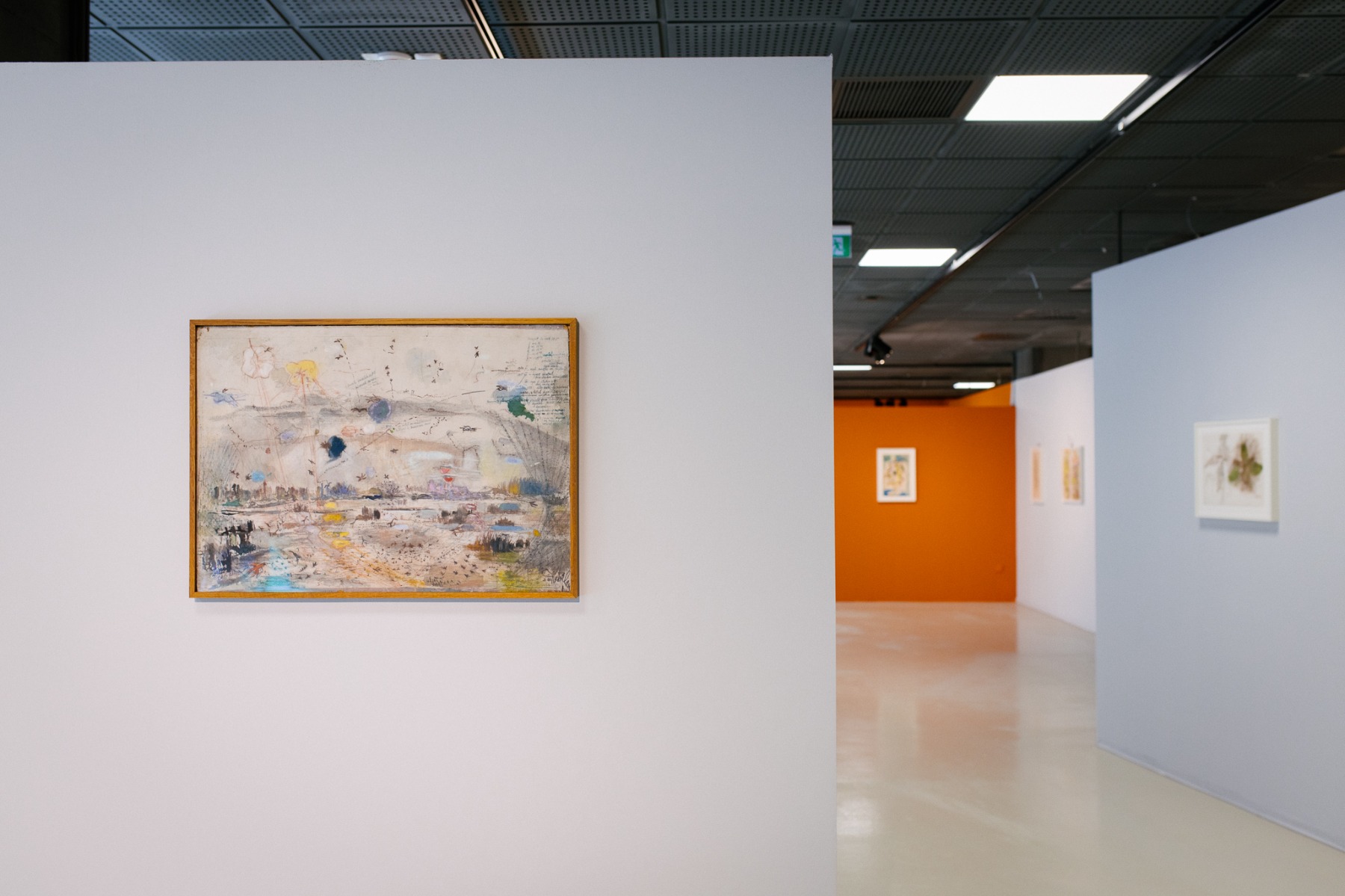
In tune with the Bertalan exhibition – and offering deeper insight into its context as well as the creative and intellectual currents of the time – visitors are also invited to explore a parallel exhibition at the National Museum of Timișoara. Titled Utopia and Research: Timișoara Experimental Groups 111 and Sigma (1966–1981), it celebrates the legendary Sigma Group and marks 55 years since its founding. As is well known, Ștefan Bertalan was one of its founders, alongside Roman Cotosman and Constantin Flondor.
In many ways, the two exhibitions complement each other, offering an almost comprehensive insight into Ștefan Bertalan’s artistic oeuvre – and showcasing a thoughtful and distinctive way in which Timișoara honors its rich artistic legacy.
Opening of the exhibition 'In Tune With the World'. Photo: © Remus Daescu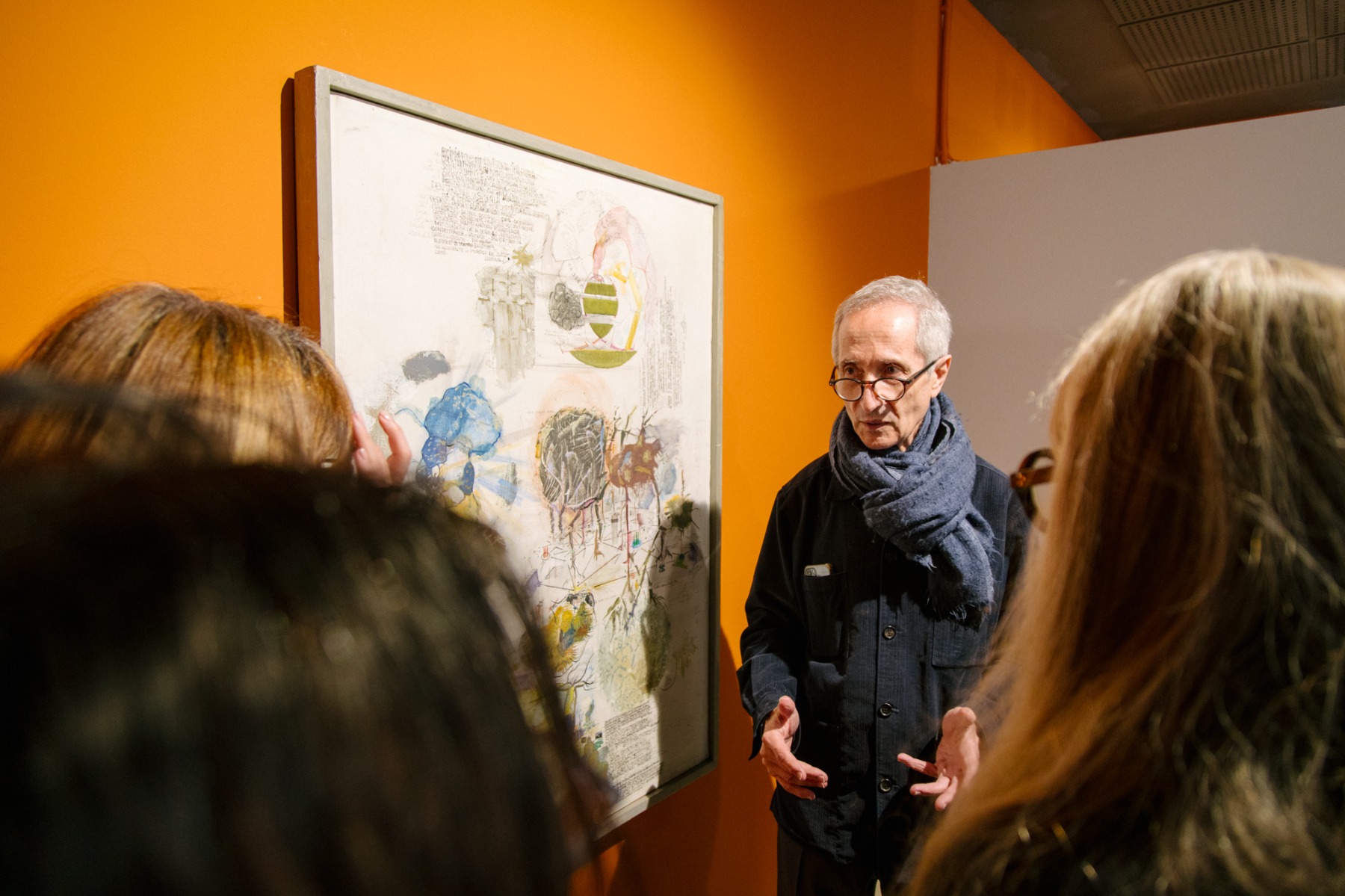
Driven by the ambition to celebrate Bertalan’s work in the most profound way – and to affirm his place in European art history – the retrospective is curated by Bernard Blistène, Honorary Director of the National Museum of Modern Art – Centre Pompidou in Paris. Blistène recalls his first visit to Timișoara four years ago, describing his encounter with Bertalan’s work as a revelation. He presents the exhibition as a deeply personal interpretation – an expression of his own response to Bertalan and his enduring legacy.
“In the course of my research – particularly during my visit to Esther Schipper Gallery in Germany, which now represents Ștefan Bertalan’s estate – I was struck by the sheer scale of the artist’s legacy. The estate comprises approximately 2,000 works, and encountering it in person made one thing clear: it would be profoundly worthwhile to trace the evolution of his practice, from his early abstract explorations to the more conceptually and formally defined phases of his career. As I began to examine the works in context, certain groups naturally suggested the structure of a retrospective exhibition. I became especially interested in his early affiliations, including his involvement with the 111 and Sigma groups, as well as his enduring engagement with the fields of bionics and cybernetics.
As part of this exploration, I discovered also the extensive writings of Bertalan, who produced thousands of pages of text in a blend of multiple languages – Latin, Italian, Romanian, German, Hungarian, and English. His writings combined technical observations with poetic reflections, often blurring the line between scientific description and artistic expression.
Ultimately, I would describe the entire body of work and its surrounding context as a true Gesamtkunstwerk – a total work of art,” says Bernard Blistène.
Ștefan Bertalan. Geometric structures, 1973-1974. Ink on paper. Courtesy the Georg Lecca Collection. Photo: Remus Daescu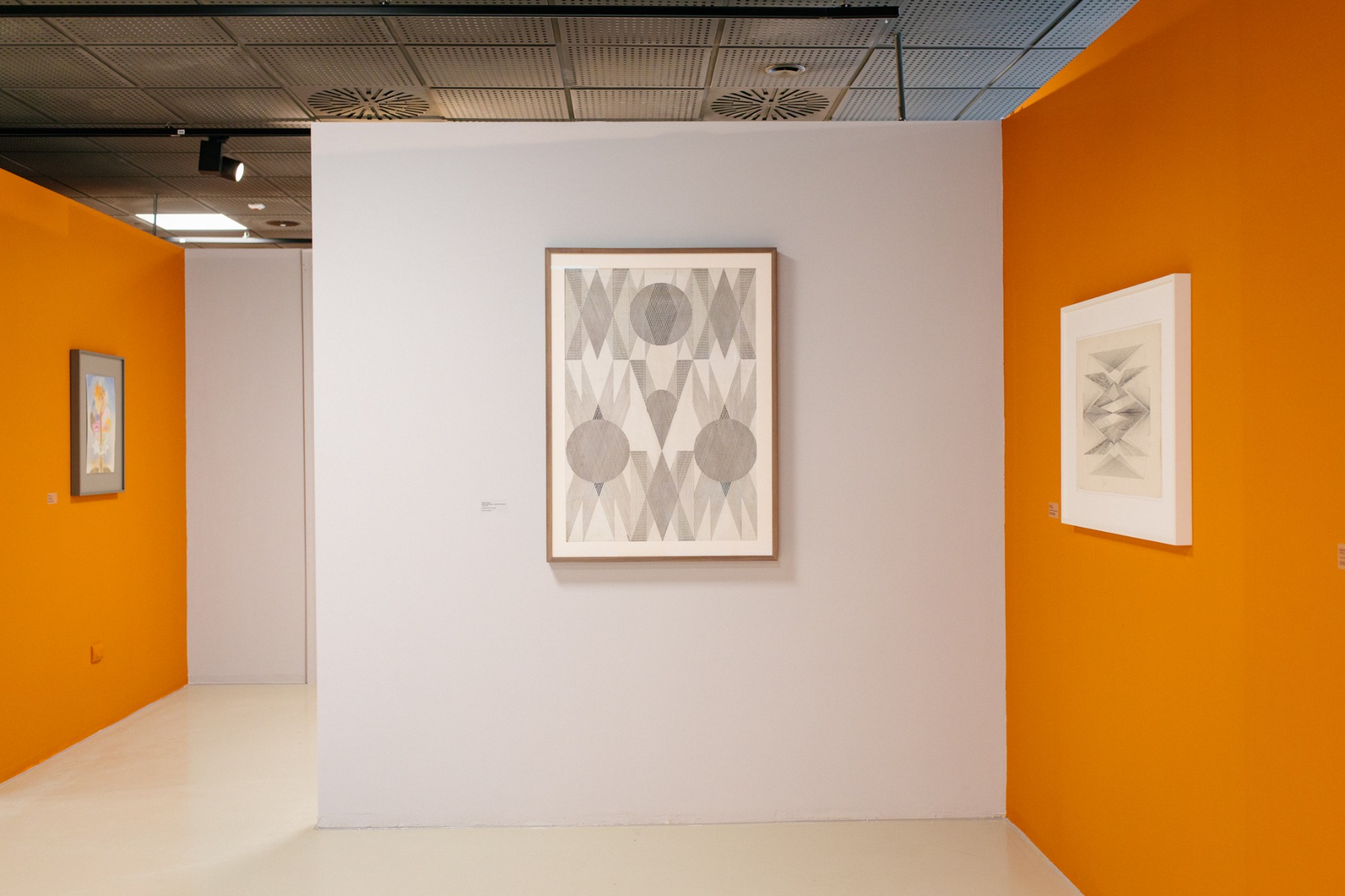
Born in 1930 in the village of Răcăştia (Hunedoara County, Transylvania), Ștefan Bertalan graduated from an art school in Cluj in 1962 – shortly before Nicolae Ceaușescu’s rise to power – and was subsequently appointed as a professor at the Timișoara Art High School. From 1970 to 1981, he taught at the Faculty of Architecture and Urbanism at the Polytechnic University of Timișoara.
In 1986, he emigrated to Öhringen, near Stuttgart, Germany, where he lived and worked until 2012. From 1990 onward, Bertalan regularly returned to Timișoara – the city he cherished and where he ultimately passed away.
Opening of the exhibition 'In Tune With the World'. Photo: © Remus Daescu
On one hand, the exhibition is a retrospective; on the other, Bernard Blistène did not want to arrange it chronologically. This is because Bertalan himself created some of his works over very long periods – five, eight, or even ten years. Therefore, the exhibition is designed as a “collection of momentum.”
“I thought it would be more meaningful to develop the exhibition as a series of moments – a sequence of experimentations – rather than trying to impose a strict chronological order. This choice was partly necessary because many of the drawings are undated, there is no comprehensive archive available, and it is, frankly, quite difficult to determine precisely when they were created. Therefore, I approached the exhibition as a collection of series, a collection of experiments – reflecting Bertalan’s deeply experimental spirit, which, I must emphasize, remained central to his practice throughout his entire life.”
Opening of the exhibition 'In Tune With the World'. Photo: © Remus Daescu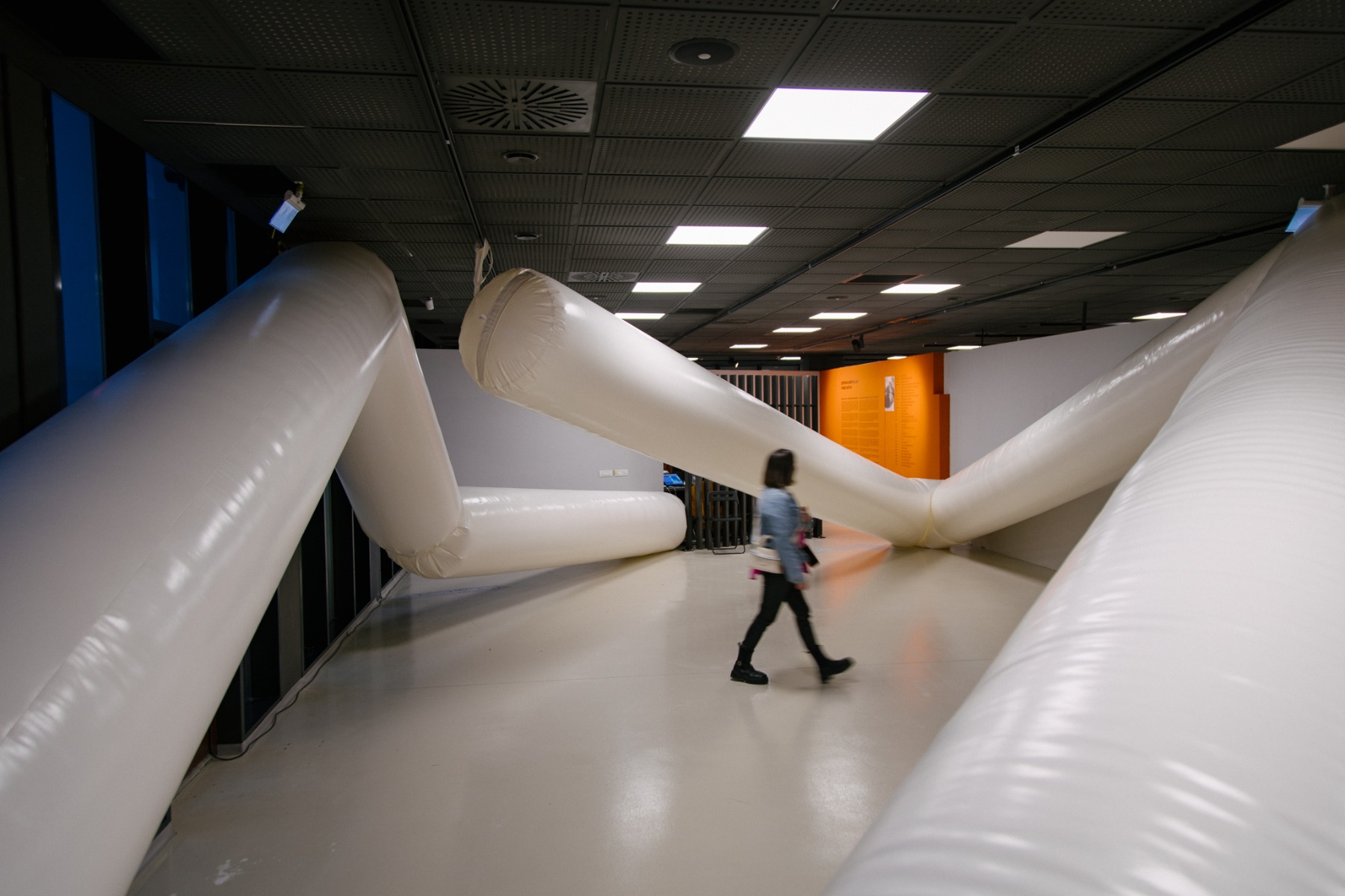
From the 1970s until his death in 2014, Ștefan Bertalan's work was deeply informed by research into cybernetics and systems theory – disciplines he explored through natural forms and organic, mineral, and vegetal processes. These investigations led him to develop a profound cosmology in which man and nature are understood as one. Bertalan worked primarily with drawing and painting, but he also pursued creative research in photography, installation, performance, and action. However, nearly ninety percent of his work is on paper.
Despite the fact that Ștefan Bertalan’s works have been exhibited at numerous renowned institutions – including the Art Museum in Chișinău (2024); Mumok – Museum Moderner Kunst Stiftung Ludwig in Vienna (2022); Kunstmuseum Liechtenstein (2020); the Art Museum in Timișoara (2012); the Venice Biennale (1995); and the Bucharest Architecture Institute (1979) – he has remained relatively unknown to the wider art scene, largely due to the political context of the time. Bertalan traveled very little during his life, with the exception of visits to Germany and a single trip to Venice, which came very late in his career. Just before his death, he attended the 2013 Venice Biennale in a wheelchair, as his works were included in the exhibition The Encyclopedic Palace, curated by Massimiliano Gioni.
He was an avid reader of Rudolf Steiner and well – acquainted with the Fibonacci sequence. His drawings resemble a scientific – artistic diary, filled with experimental observations, speculations, visions, and theoretical reflections. Research into – and an understanding of – universal cosmology, as well as his own place within it, was the driving force behind his work. He devoted himself to this pursuit with near – maniacal intensity.
Stefan Bertalan. Garbage - garbage bin and icosahedron, 1979 © Remus Daescu
A tireless observer, he dedicated much of his life to studying the structures of plants and animals, the interplay of light and shadow, the sky’s meridians, and the position of the sun. At times, he would spend several days meticulously drawing and studying the wind. In some of his works, the direction of the wind is marked with symbolic notations. There is always a sense of continuity, as one drawing flows into the next, depicting recognizable landscapes – rivers, mountains – and reflecting an immersive, profound connection with the natural world.
In this way, he evokes the universal spirit of artists like Leonardo da Vinci – though articulated entirely in his own singular voice.
Ștefan Bertalan. Untitled, 1963. Gouache on paper. Courtesy the Estate of Stefan Bertalan and Esther Schipper, Berlin/Paris/Seoul. Photo: Remus Daescu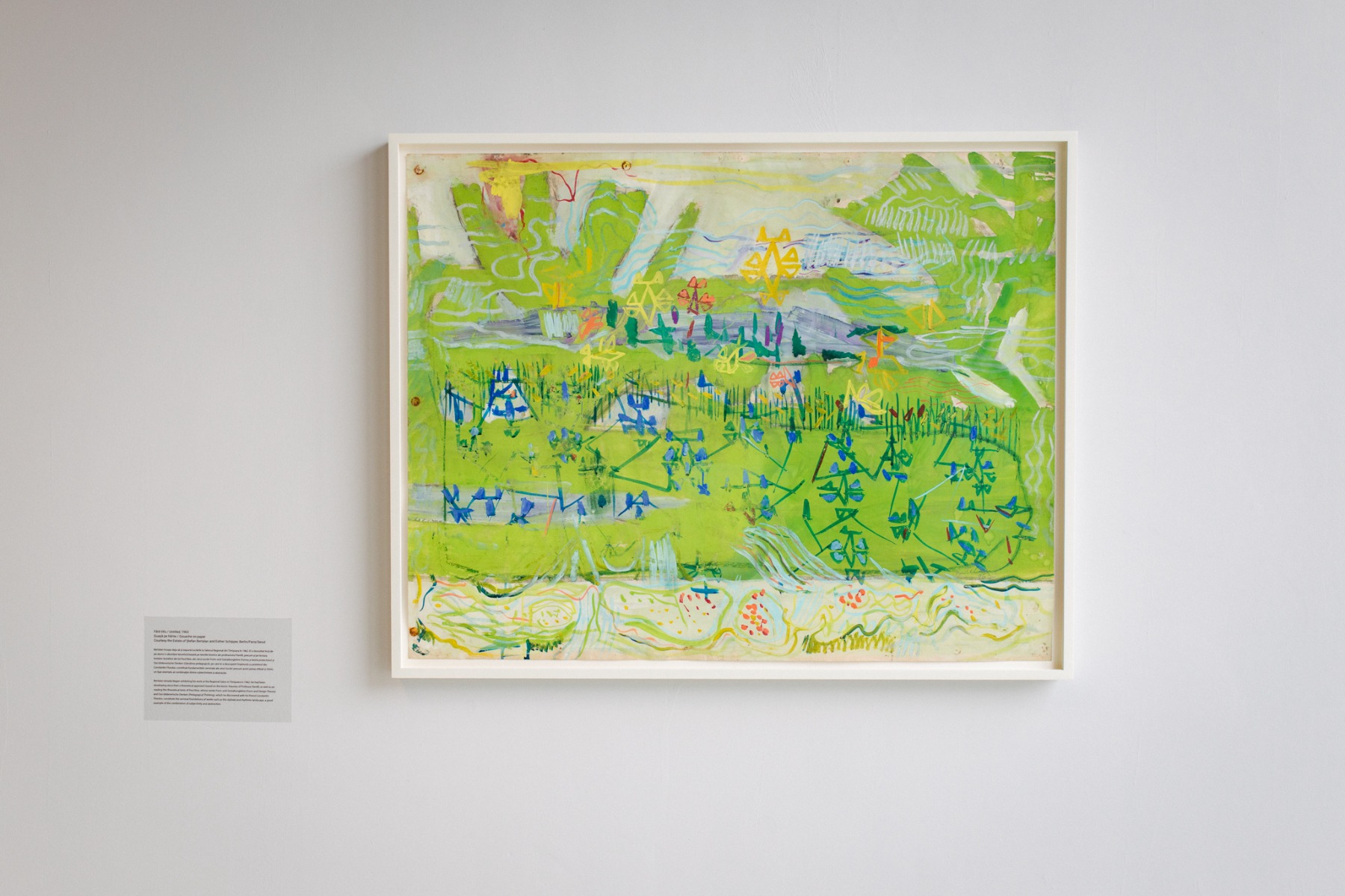
As Bernard Blistène points out: “Another important aspect is the repetitive loop that characterizes many of Bertalan’s works, stemming directly from his understanding of the bionic world. According to bionics, rotation begins on the right side and develops in a spiral shape – this is clearly visible in his early works. Bionics also reveals the connection between nature and culture, or between abstraction and figurative art. It seems to me that Bertalan spent his entire life not trying to reconcile these spheres, but rather to unite them – to reformulate the relationship between abstraction and figuration that defined the 20th century.”
Opening of the exhibition 'In Tune With the World'. Photo: © Remus Daescu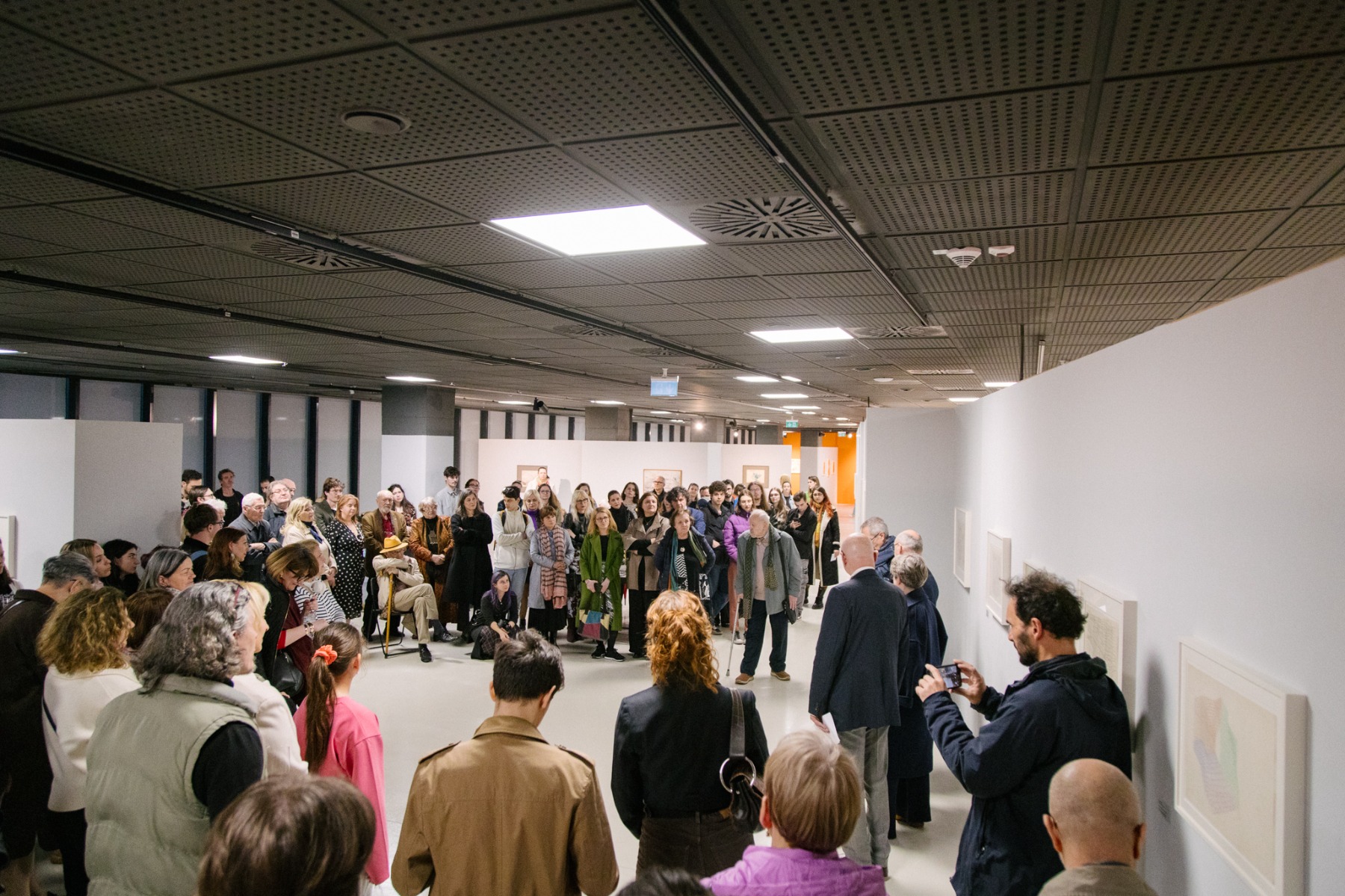
He could also spend countless hours almost synchronizing with the structures of plants. “He was a great admirer of sunflowers, which are very common throughout Romania. As we know, sunflowers have a unique attraction to the sun, their heads turning to follow the light and changing their color spectrum. In one particularly beautiful drawing, Bertalan analytically studies sunflowers, also integrating images of birds. He devoted considerable time to photographing birds, fascinated by their flight – a motif that naturally evoked themes of elevation and connection to the sky.
Stefan Bertalan. Untitled (Sunflower), 1979. Gouache, crayon and pencil on paper. 50 x 32,5 cm (19 3/4 x 12 3/4 in) (STB 736). Courtesy the Estate of Stefan Bertalan and Esther Schipper, Berlin/Paris/Seoul. Photo: Remus Daescu
His fascination with sunflowers later culminated in a performance and installation titled 130 Days with a Sunflower (1979), which was exhibited in Bucharest alongside related drawings, photographs, and a handwritten diary.
Later, he purchased a microscope to observe tiny insects, plants, and seeds in intricate detail. “Someone told me he once spent 120 days carefully observing the development of a single plant. This reveals an inner shift – a growing focus on the microcosmic, as he turned away from the harshness of external reality.”
Exhibition view. In the centre - Ștefan Bertalan. Conopida/Cauliflower, 1977-1984. Watercolor and gouache on canvas. Courtesy the Brukenthal Collection. Photo: Remus Daescu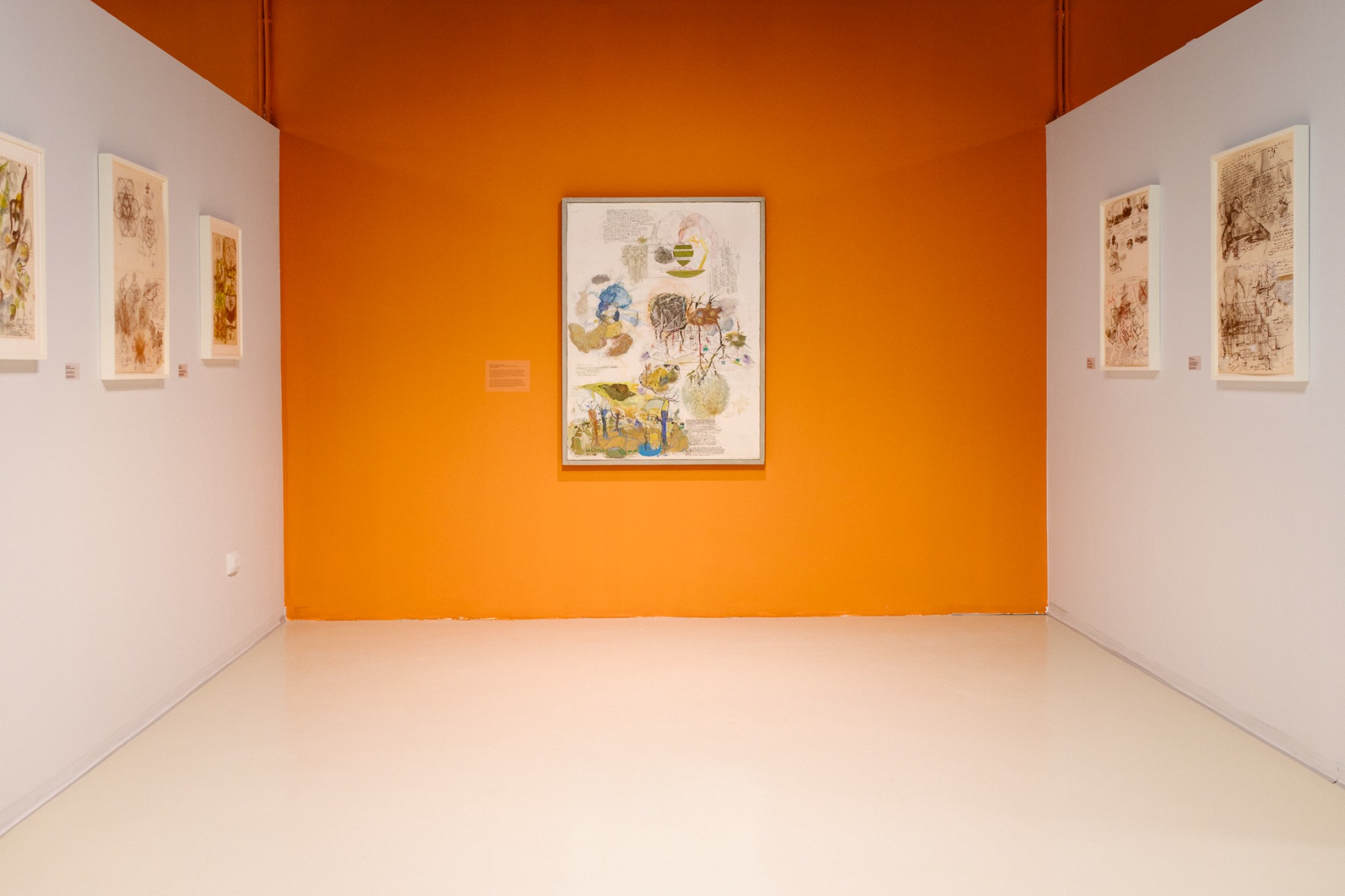
In 1978, he collaborated on a film that closely examined the structure of a cabbage.
He was especially fascinated by the patterns in plant leaves, carefully observing how sap flows through their networks. A separate series focused on the potato, which captivated him through its transformative cycle. He explored how a potato begins to sprout, surrendering its life force to the next generation. To some extent, he drew parallels between this transformation and human life, noting that, unlike many other plants, the potato ages in a way reminiscent of the human body. This reflection culminated in a striking series of self – portraits in which Bertalan depicted himself as a potato, emphasizing the theme of irregularity by showing how the oval shape of the human face becomes distorted and uneven with age.
Through prolonged observations, many sleepless nights, and dreamlike visions, he arrived at a profound understanding of the interconnectedness of all things. Illustrating an intricate cosmology of connection, he created an inspiring and revealing series of works where landscapes, atomic structures, and vegetal forms seamlessly merge.
Exhibition view. Courtesy the Brukenthal Collection. Photo: Remus Daescu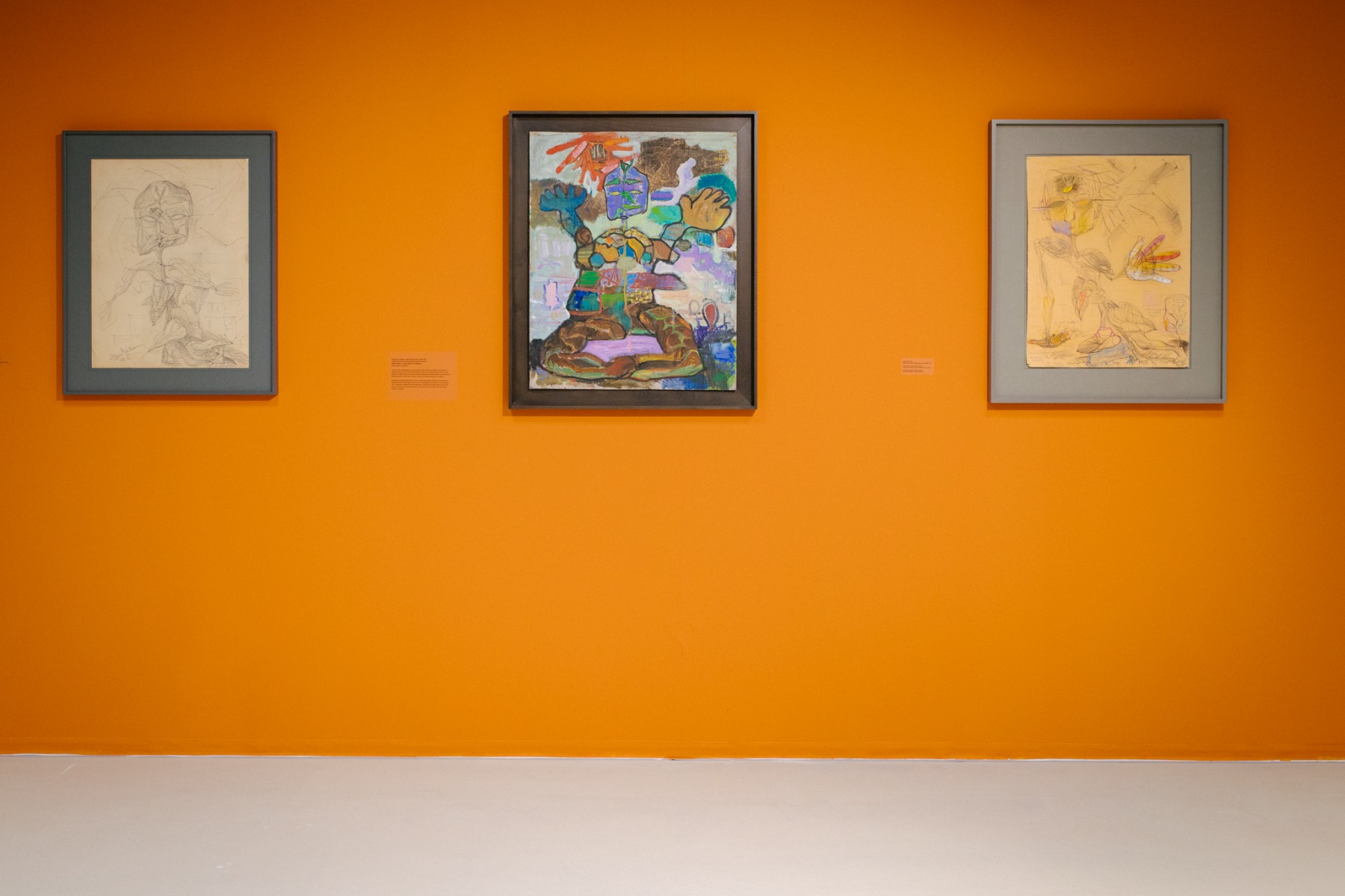
As Ștefan Bertalan’s son remarked at the exhibition opening, his father was quite depressed toward the end of his life, struggling with illness. “He was depressed, but his depression manifested differently than in others. Despite this, he remained productive – absolutely.”
The exhibition stands as a powerful tribute to a visionary artist whose ahead – of – his – time, holistic ideas on the symbiosis between humans and nature – and whose relentless inquiry into the universal order – resonate with renewed urgency today.

Title image: Ștefan Bertalan. Geometric structures, 1973-1974. Ink on paper. Courtesy the Georg Lecca Collection. Photo: Remus Daescu